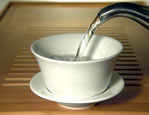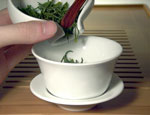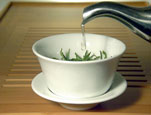Kínai
kajvan-tea
Forrás:
www.imperialtea.com/tea/GaiwanPrep.html
Teakult, a Terebess Online különlapja
Kajvan (gaiwan) = háromrészes kínai teáscsészék
Hagyományos kínai teafőző és ivóedény, nyugaton egy másik kínai nevet is használnak rá: csung (zhong).
Kungfu teázásnál nem isznak belőle, teáskannaként használják, fedele egyaránt szolgál a hő megőrzésére, a tea kavarására és szűrésére.
Iváshoz mindhárom részét (aljjal és fedővel együtt) emelik a szájhoz, a fedővel hátrasöprögetve az ázó tealeveleket, a másik kéz pedig nem közvetlenül a forró csészét fogja, hanem a csészealjat.
Zöld tea forrázásánál a vizet a csésze egyik oldalára folyatják, hogy örvényszerű mozgásba jöjjön. Az ázás ideje alatt nem fedik le. Ha kész, a fedővel visszatartják a tealeveleket, és rendszerint átöntik egy másik csészébe, mindig hagyva egy kevés teavizet a leveleken, amelyeket (késedelem nélkül!) újra lehet forrázni.
Pu-Erh vagy oolong teánál leöblítik a leveleket, majd az első forrázatot azonnal kiöntik. Ez kibontja a leveleket, felszabadítja aromájukat és kioldja belőlük a kesernyés ízt.
| Gaiwan Tea Preparation | |||||
| 1. RINSE - Whatever the type of tea being brewed, the first step is always to rinse cup with hot water. This performs two functions: first, it purifies the cup (both practically and symbolically) by rinsing away any dust or residue and symbolizing that the cup is clean, empty and ready to receive the tea. Secondly, rinsing with hot water warms the cup – which, at room temperature, is quite cold and therefore inappropriate for brewing most fine teas whose temperature must be carefully controlled. The water should be poured from the gaiwan into the serving pitcher and from there into the tasting cups to warm them and then discarded. |  |
||||
| 2. TEA LEAVES - The tea leaves should be prepared in advance and ready to be placed in the gaiwan as soon as it has been warmed. (A tea caddy or “tea presentation vessel”, as shown, is recommended for this purpose, as is a proper set of tea tools.) Approximately one to two teaspoons of leaf is a good quantity to begin with and is easily adjusted to taste after the initial infusion. Keep in mind that due to the many variations of tea processing, some leaves are a lot more compact than others. For instance: you’ll need a lot less Dragon Well or Jasmine Pearls than Silver Needles or Formosa Oolong. |  |
||||
| 3. AROMA - Before infusion a few drops of water from the kettle should be added to the leaves. This releases the tea’s aroma and should be savored prior to infusion in order to prepare the palate to appreciate the full flavor of the tea and also suggests to the experirenced tea maker how to approach the infusion (i.e. in terms of temperature, time, etc.). Alternatively, some people like to cover the leaves with hot water and quickly pour it off. This is known as “flushing” the tea and is recommended particularly for tightly rolled and aged teas, such as oolong and Puerh. As above, the wet leaves’ aroma should be appreciated before brewing. |  |
||||
| 4. WATER –
99% of tea is water, so it’s important to give some thought to
the water you use for brewing. Tap water should be avoided since its
chemical treatment imparts undesirable flavors and odors which interfere
with the delicate aromatics of tea. (Home filters and other water
purification systems can minimize and, in some cases, eliminate these problems.)
The best water for tea brewing is spring water with a natural mineral content
that’s neither too hard nor too soft. Since T.D.S. “total
dissolved solids”, or mineral content measured in parts per million
varies greatly from water to water, you may want to do your own taste-test
of waters available in your area to determine which one has the best flavor,
body and compatibility with the tea you drink. -An interesting Swiss-based
website to consult in this regard is mineralwaters.org NOTE: Distilled water is not recommended for tea since water purified of its mineral content produces a flat-tasting infusion. |
|||||
5. INFUSION
- When it comes
to infusion, water temperature and steeping time are just as important as
the quality of the water and tea leaves used. Unfortunately there
are no set rules for either, but the following guidelines may be used for
starters:
|
|||||
| 6. SERVICE – When the tea is ready the gaiwan should be covered and picked up on its plate with the left hand and placed on the up-turned fingers of the right hand. The lid should be positioned slightly askew and held in place with the thumb – just enough to allow the tea to pour out while retaining the leaves. (Using two hands may at first appear to be easier, but it actually makes pouring more difficult, while using one hand locks the three pieces in place and holds them together as the gaiwan is inverted for pouring.) Pour the tea into the pitcher and then serve in individual tasting cups. | |||||
|
|||||
| 7. RESTEEPING –
One of the benefits of using high quality, full-leaf teas is that they do
not instantaneously “leech out” like the chopped-up tea found
in teabags and, as a result, may be resteeped – generally 2 or three
times, sometimes more. To resteep it is usually necessary to increase
the infusion time slightly and also to reheat the water – at least
to the original infusion temperature, sometimes higher.
NOTE: It is not recommended that tea leaves be left for any length of time between infusions. |
|||||